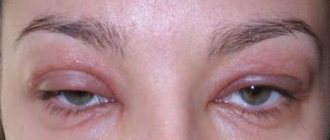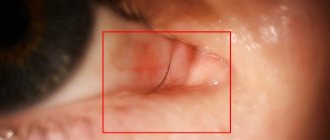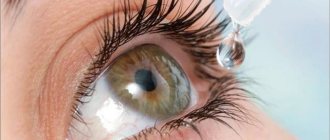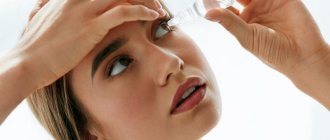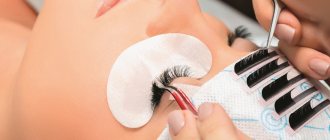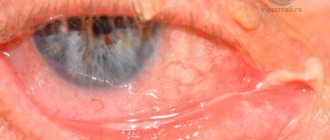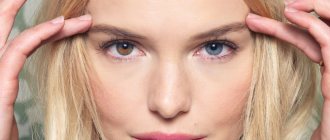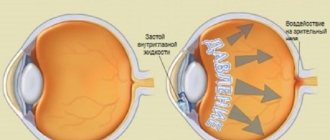An allergy is a disease in which a person encounters an active component that he cannot tolerate. After the pathological agent enters the body, the person begins to produce antibodies in order to destroy the allergen. This is a kind of protective reaction of the body, but the disadvantage of such a reaction is that the “battlefield” of the allergen and antibody is the body. The manifestations of such a struggle are varied and very often similar to other diseases. Depending on which part of the body the allergen has come into contact with, certain reactions that the allergy provokes develop. The eyes itch for many reasons, for example, if the allergen has come into contact with the mucous membrane of the eyes.
A brief overview of eye diseases that cause itching, burning, and redness
Allergies to the eyes manifest themselves in several types, depending on what kind of allergic reaction is manifested:
- Keratoconjunctivitis - may appear in the spring. The disease affects boys under 12 years of age to a greater extent due to undeveloped hormonal levels. This type of allergy is chronic.
- Hay conjunctivitis appears during the flowering of plants and trees and disappears with the onset of cold weather.
- Inflammation from contact lenses. This type manifests itself implicitly, but constantly progresses.
- An allergic form of an infectious nature appears due to inflammation in the oral cavity and nasopharynx. This allergic reaction occurs as a result of ARVI.
- Allergic reaction of large-papillary type. It mainly manifests itself in people who stay indoors for a long time, where the air contains many small particles.
- Drug-induced conjunctivitis is the name given to a reaction provoked by taking medications.
The reaction can be acute or chronic. The acute type develops within an hour after encountering an allergen. The chronic type begins to be reflected a day after contact, it manifests itself with weak signs that subside or arise with renewed vigor.
How dangerous is an allergy if it affects the eyes?
Allergy eye drops
To treat eye allergies, doctors recommend using special drops. They put less strain on the eyes and are often more effective. Allergic manifestations are treated with antihistamines and vasoconstrictors.
Their brief characteristics are presented in the table:
| Name | Mode of application | Duration of treatment | Price |
| Antihistamines | |||
| Dexa-Gentamicin (Dexamethasone) | Instill 1 drop into the conjunctival sac 6-8 times a day | The therapeutic course is selected individually. | 170 RUR |
| Ketotifen | Order 1 drop 2 times/day. It is forbidden to use for children under 12 years of age. and expectant mothers. | The duration of treatment is determined by an allergist. | 50 RUR |
| Alomid | The drug relieves irritation and allergic inflammation in the first day after the onset of symptoms. Dosage – 1 drop every 6 hours. | No longer than 2 weeks. | 45 RUR |
| Lecrolin | These allergy drops are used to treat children (from 4 years old). Instill in only the affected eye no more than 4 times a day. | Apply until the plants stop blooming. | 90 RUR |
| Vasoconstrictors | |||
| Visine | The drug eliminates redness, discomfort and itching. Prohibited during pregnancy. Instill 1-2 drops no more than 4 times a day. | No longer than 4 days. | 300 RUR |
| Visoptic | For allergies in the eyes, these drops are used to treat both adults and children from 3 years of age. Instill no more than 2 drops into the conjunctival sac. Maximum 4 times a day. Side effects such as itching or pain are possible. | No longer than 4 days. | 180 RUR |
Related article: Allergy to gold from wearing jewelry
The upper/lower eyelid swells, the skin around the eyes flakes and itches - reasons
Many factors can cause peeling of the eyelids and redness of the eyeballs. This could be poor nutrition or the use of defective cosmetics. But most often, such a manifestation indicates that a disease is developing in the body, a disruption in the functioning of internal organs.
Burning eyes, the causes of which should only be determined by ophthalmologists and allergists, cannot be eliminated with cosmetic external preparations. A characteristic sign of an allergy is considered to be redness on the eyelids, watery eyes, peeling, and itching.
This is usually a seasonal phenomenon that occurs during the flowering period. In addition, swelling and peeling may occur due to:
- dust;
- cats or dogs;
- bites of any types of insects;
- cosmetics;
- household chemicals;
- medicines.
If the source of the allergy cannot be determined, skin tests are taken at the clinic. Thanks to them, you can determine the allergen 100%.
Treatment of eye allergies
What to do if a child or adult has the symptoms described above? Eye allergies can be treated in different ways: antihistamine tablets, ointments (creams), drops. It is not recommended to prescribe the drug to yourself.
The eyes are an important organ and must be protected. You should not ignore the advice of ophthalmologists.
Antihistamine tablets
Antiallergic tablets block the activity of the allergen, preventing it from negatively affecting other organs and tissues. For example, they prevent swelling and itching of the mucous membranes of the nose and throat.
The most popular antihistamines are presented in the table:
| Name | Reception schedule | Duration of treatment | Price |
| Cetirizine | 1 tablet/day | from 7 days to 2 weeks | 60 RUR |
| Chloropyramine | 1 ampoule/day | from 3 days to 2 weeks | 80 RUR |
| Tsetrin | 1 tablet/day | from 1 day to 2 weeks | 150 RUR |
| Tavegil | 1-2 tablets/day (before breakfast and/or evening) | 2 weeks | 200 RUR |
| Suprastin | half a tablet or 1-2 tablets/day | from 3 days to 2 weeks | 150 RUR |
| Levocetirizine | 1 tablet/day | from 3 days to 2 weeks | 300 RUR |
| Loratadine | 1 tablet/day | 2 weeks | 100 RUR |
Puffy eyes, irritation, redness - the differences between a cold and an allergy
Nature has thought out how to protect the eyes in a natural way - this is a tear.
It eliminates bacteria that enter the cornea. Active evaporation of tears occurs in the wind. This leads to drying out of the mucous membrane. As a result, the friction of the eyelid on the surface of the mucous membrane increases. Due to the fact that there are few tears, germs remain with dust in the eyes. This leads to the onset of inflammation. You can inflate your eyes quickly. This happens if:
- Walking in strong winds or under a fan or air conditioner.
- Be in a drafty apartment.
- Swim in the cold wind.
- Drive with the car windows open.
When the wind blows into the eyes, irritation develops. If you do not get rid of it at the initial stage, infection may occur, which leads to the following pathologies:
- Conjunctivitis is a process of inflammation of the mucous membrane of the eyeball.
- Dacryocystitis is a pathology of the canal, which is necessary for the drainage of tears.
- Barley is the process of inflammation of the eyelash bulb, the eye becomes inflamed from the outside, and a purulent formation appears.
Allergy to the eyes
If your eyes are puffy, you can tell by the following signs:
- the eyes become red, itchy, and there is a burning sensation;
- there is a feeling that something has got into the eye;
- eyelids swell;
- vision decreases;
- body temperature rises;
- Pus appears in the corners of the eyes in the morning.
If eye inflammation is the result of a viral pathology in a person, ARVI, he will be bothered by a high temperature, chills, and snot may appear. In such situations, it is necessary to eliminate the virus in the body as a whole.
Provoking factors
Allergies provoke the appearance of symptoms such as itchy eyes. So, during the flowering of certain plants, a burning sensation occurs. Particles of dirt that are on the face can cause skin irritation. Therefore, you need to wash your face and wash your eyes more often. If this is not done, the sebaceous secretion will provoke unpleasant sensations and provoke the development of allergies.
Itching also occurs because foreign objects and insects get into the eyes. You should not touch the mucous membrane with dirty hands; it is better to rinse it with running clean water, or use a handkerchief. You immediately need to move the foreign object to the corner of the eye and then remove it.
If any chemicals, gaseous or liquid, come into contact with your eyes, you should wash them immediately. You can't hesitate.
Trichiasis causes redness of the eyes. A clear sign of this is eyelashes growing in the wrong direction. For this reason, it is impossible to completely close the eyelids and provide the protection they need.
During inflammatory processes on the mucous membranes of the eyes, the inner part of the eyelid is covered with a thin film, and dilation of blood vessels occurs. Because of this, the eyes become red and a large amount of tears are produced.
Due to the fact that there is not enough fatty secretion and the tear film is poorly protected from evaporation, “dry eye” syndrome occurs. This reaction is most often observed in older people. It is provoked by dry indoor air, cigarette smoke, hot climate, and wearing contact lenses.
How allergies manifest themselves on the eyelids and eyes - symptoms
Reactions in the eyelid area are associated with increased skin sensitivity.
This creates all the conditions for the penetration of allergens. Symptoms of allergic reality appear three hours after exposure to the intolerable substance. Symptoms of allergies on the eyelids are:
- There is a burning sensation in the eye area.
- Swelling appears and the skin turns red.
- There is a feeling of tension in the eyelids.
- Peeling and rash appear around the eyelid.
- Sensitivity to light increases.
Swelling may occur and spread to the inside of the eye.
When you have allergies, your eyes itch, what should you do at home?
Diagnosis of allergies in children and adults
Redness and itching in the eyes are reasons to go to the ophthalmologist. Only he can make a diagnosis and prescribe the correct treatment. The examination is carried out using laboratory methods. This is necessary in order to determine the source of the allergy.
To identify the allergen, the doctor collects general information about the patient:
- Are there any cases of allergy tests in relatives?
- Presence of a reaction to medications.
- Dependence of the manifestation of symptoms on the time of year.
- The influence of climate on the development of the disease.
- The relationship between food consumption and the use of household products and the manifestation of symptoms.
If the examination is carried out on an infant, much attention is paid to the process of pregnancy. The mother's nutrition plays an important role during pregnancy. Most often, allergens enter the bloodstream in the womb.
To identify the disease, the doctor prescribes a general blood test. In case of allergies, the blood will contain a large number of eosinophils.
In addition, allergy testing is carried out. This is a method that determines the body's sensitivity to certain substances.
The eyelids hurt and are swollen, tears are flowing - what to do, how to remove them, how to treat them?
If an allergy appears on the eyelids, treatment is prescribed only by a specialist. The method will depend on the reason. Treatment will differ depending on whether the problem occurs in cool weather or after going to the pool, or whether the redness is accompanied by sneezing and a stuffy nose.
If it is clearly clear what the reaction is to, the simplest method is to completely isolate the person from the allergen. Signs of the disease are relieved with local therapy.
For eye allergies, drops are most often prescribed. The main assets include:
- Albucid - drops that are prescribed to relieve symptoms in children.
- Alomide - used to combat dryness on the surface of the mucous membrane. Creates a tear substitute.
- Visine - works well to relieve swelling of the eyelid and eliminate redness.
Antihistamines can eliminate itching and burning sensation, relieve inflammation of the eyes and tearfulness. If the manifestation of allergies is acute, anti-inflammatory drugs may be recommended.
Types of allergic diseases that manifest themselves in the eyes
The eyes itch or water, depending on the type and type of allergic manifestation; the most severe ones can lead to inflammatory infections of the cornea and vascular network of the eyes, as well as damage the retina, and in extremely severe cases cause damage to the optic nerve.
The most common ocular forms of allergic dermatitis and conjunctivitis are listed below:
- Allergic conjunctivitis. With this disease, the eyes become unbearably itchy and there is severe lacrimation and swelling of the eyelid. Treatment consists of taking antihistamines and eliminating the allergen.
- Dermatitis of allergic etiology. This disease affects the eyelids and skin around the eyes and is characterized by redness, rashes and severe itching. Dermatitis of allergic etiology is often caused by the use of low-quality or expired cosmetics. Also, this disease can be triggered by exposure to coal dust, construction dust, glass wool or any other mechanical irritants. Treatment consists of eliminating the aggressive agent, taking antihistamines and applying soothing ointments to the skin around the eye.
- Pollinous conjunctivitis. In another way, this disease is called seasonal allergy to pollen of certain plants. This disease often affects patients in the spring and summer. The main manifestations of this pathology are lacrimation, itching, and photophobia. The key symptom of this pathology is the appearance of nipple-like growths on the eyelids. If this type of conjunctivitis affects the patient for several years, before the start of the season it is necessary to begin preliminary treatment by taking long-term antihistamines. If the disease appears for the first time, treatment includes daily intake of anti-allergy medications and consultation with a dermatologist.
Treatment of reactions such as burning and red eyes
Burning sensation, swelling, redness of the eyes, how to relieve it is prescribed by the doctor. It is very easy to eliminate the symptoms with the help of medications. But sore eyes return after encountering an allergen.
Redness and burning of the eyes may not occur on their own, but may be accompanied by a runny nose, headache, and coughing attacks. In these cases, an integrated approach to therapy is required, which must be based on anti-allergenic drops.
For various reasons, the vessels in the eyes become wider, turn red, and it looks like reddened, inflamed whites.
Drops to eliminate redness of the eyes must contain vasoconstrictor components:
- Tetrizoline.
- Lecrolin.
- Opatanol.
- Allergodil.
Traditional methods of treating allergic redness in the eyes are very popular. For example, you can relieve redness and fatigue from the eyes with a bag of black or green tea. To do this, you can apply a lotion for 30 minutes.
Potatoes will relieve pain and redness in the eyes. One root vegetable should be cut in half and applied for 30 minutes.
Prevention of pathology
To avoid unwanted reactions, it is recommended to follow simple preventive measures:
- Try not to come into contact with the source of the allergen.
- Carefully monitor personal hygiene.
- Rinse your nose after going outside.
- When going out into the sun or frost, use drugs to create artificial tears.
- Get good sleep at night.
- Timely treatment of eye infections.
Allergy treatment should not be neglected. An advanced disease can lead to the development of a chronic type. This will negatively affect your vision. When the first signs of dryness or, conversely, watery eyes, red eyes, or burning appear, you should consult an ophthalmologist.
Next Post
Previous Post
What to do?
Washing your eyesight will help relieve symptoms.
If the organs of vision begin to itch very often due to allergies, then to prevent the development of the disease it is necessary to wash the eyes 2 times a day and try not to touch the visual organs with dirty hands. Also, you should not use expired cosmetics. When working in dusty conditions, protect your eyes with goggles. To reduce the number of allergens, the room is wet cleaned every day, and a respirator is used when working with chemicals. If infectious diseases of the optical system occur, it is necessary to treat them and take vitamin complexes to increase immunity. Spend more time walking in the fresh air.
How to treat with medications?
Treatment of any type of conjunctivitis caused by allergies includes the following principles:
- limiting the patient’s contact with allergens;
- drug therapy;
- increasing immunity.
For drug therapy of all types of conjunctivitis, the following drugs are used:
Tablet antihistamines can be taken for up to a week.
- Antihistamines. Used internally for more serious types of allergic reactions. The tablets are taken in a course of 3-6 days.
- Cream and ointment. Corticosteroid (hormonal) medicine is used only for complicated allergic reactions, as it can cause atrophy of the ocular membrane. If an infection is added to the allergy, then antibacterial agents are used.
- Eye drops: vasoconstrictor;
- antihistamines;
- anti-inflammatory.
The table shows the most popular pharmaceutical drugs for the treatment of allergies:
| Type of medicine | Name |
| Antihistamines | "Claritin" |
| "Tavegil" | |
| "Zyrtec" | |
| "Loratadine" | |
| Creams and ointments | "Celestoderm" |
| "Advantam" | |
| "Erythromycin" | |
| "Gistan" | |
| Eye drops | "Okumetil" |
| "Allergocil" | |
| "Opticrom" | |
| "Vizin" | |
| Multivitamins | "Duovit" |
| "Supradin" | |
| "Aevit" | |
| "Alphabet" |
"Okumetil"
Okumetil will quickly solve the patient’s problem.
A combined drug in the form of drops that relieves eye itching very well. Also used for different types of conjunctivitis. Sometimes after instillation there is a feeling of burning and stinging. Contraindications:
- glaucoma;
- epilepsy;
- diabetes;
- pregnancy;
- bronchial asthma;
- arterial hypertension.
"Diazolin"
Antihistamine tablets are also used to relieve itchy eyes for eczema, hay fever and insect bites. After taking the pills, sometimes there is heartburn, nausea, dizziness, drowsiness, and urinary retention. Contraindications:
- arrhythmia;
- inflammation of the gastrointestinal tract;
- epilepsy.
